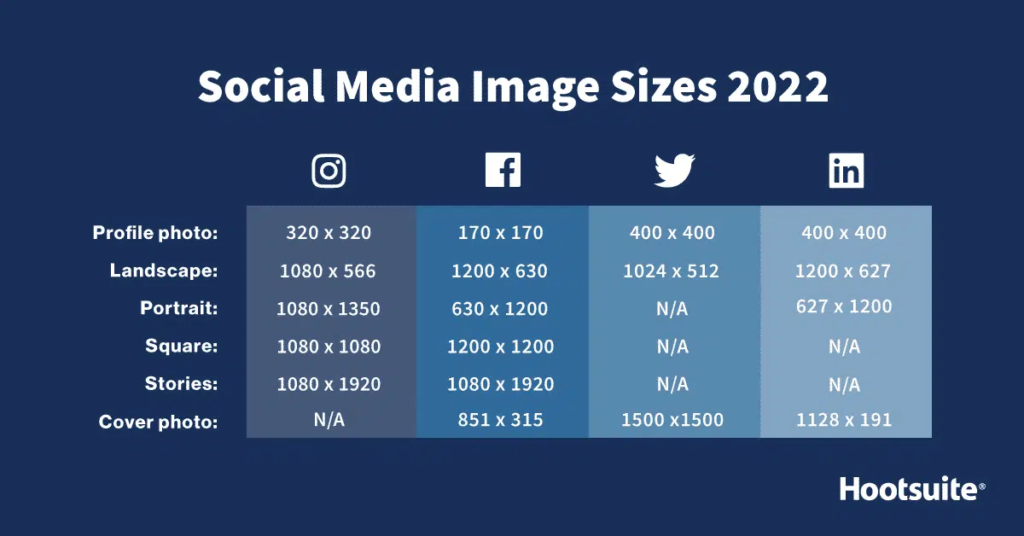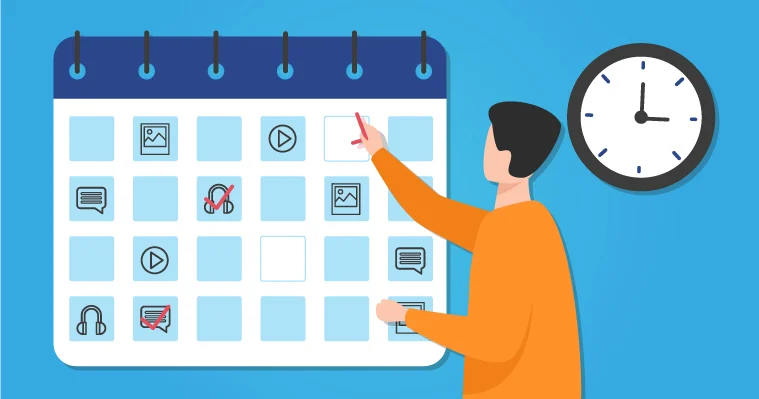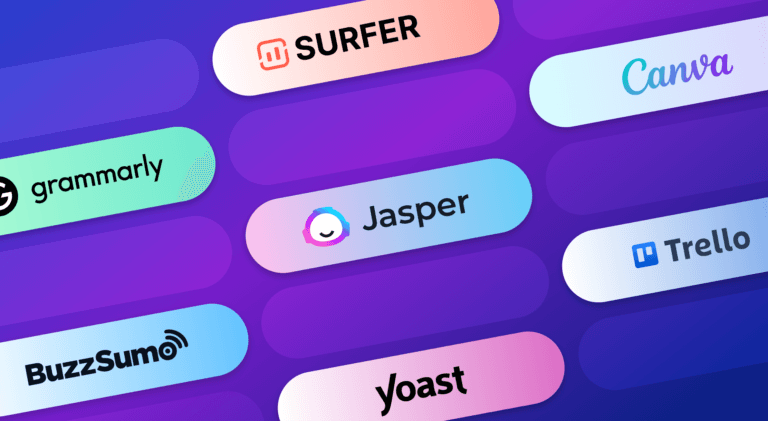How and When to Publish Content in Order to Score Big on Social Media

The popularity of this success mantra is widely acclaimed. And social media marketing is the best platform to validate this. Why? Because social media best practices recommend that along with spending hours drafting a perfect copy for social media posts, marketers should spend an equal amount of time planning and strategizing the post too.
An ideal social media post might fail to gather consumer attention if not planned correctly. In this article, we will discuss the right time and way to publish on social media platforms, as each platform serves a different purpose and caters to a completely different set of audiences.
Let us start with how marketers can make the most of their social media pages.
How to Publish on Social Media?
An apt social media post is the one that is relevant, in tune with the ongoing trends, visually appealing, has engaging content, and has credibility. Along with these, there are other factors, but these few are the must-dos.
Follow the trends and hashtags
In the virtual world of social media, trends change every day of the week. Making posts around or about the ongoing trends increases the chances of your post getting into the popular content category. Using hashtags (relevant ones) plays a major role in making your post appear among the trending posts or posts about a particular trend.

Select the best channels for your business
Not every social media platform is right for your business. LinkedIn is not a relevant place for you if you run a jewelry store, but Instagram, Facebook, and Pinterest are. So, firstly, you need to find the most relevant platform to connect with your potential consumers.

Social media style guide
A style guide is basically noting down the overall experience you want a user to have while visiting your social media pages. You should establish your style guide in tune with the core objective of your business. These five steps have helped marketers design their style guides:
- Align your social media profiles
- Document your brand’s tone and voice
- Create posting guidelines
- Set image guidelines
- Decide on how you will respond in certain situations

Tag accounts with Influencer content
Investing in influencer content increases your chances of being recognized as a credible brand. Tagging verified accounts of people and organizations also encourages others to share your post. However, here are a few pros and cons of influencer content:
Pros
- Since most people trust influencers, they can lend a good amount of credibility to any brand
- This format of content allows you to reach out to trusted authorities
- Influencer content generally includes paid agreements but sometimes influencers market your content for free if it is good quality and useful to their audience.
Cons
- The entire process and its maintenance is time-consuming. Finding the right influencer to continuously working on new ideas for influencer campaigns takes a lot of time and effort.
Correct image size
Consumers are always first attracted to the image element of your social media content. You might lose a potential consumer if it fails to make an impactful first impression. So, a high-quality, sharp image with a clear message is always recommended for social media content publishing. It must also be posted in the right size, as every social media site has different layouts and formats.

Best Time to Publish on Social Media
Great content is essential for a successful content marketing plan, but what’s equally important is the timing for social media content publishing. A month early or late might make your campaign less relevant and impact its total social reach.
The simplest way to understand this is to put yourself in the customer’s shoes. Think from a consumer’s point of view; what kind of content you would want at what time of the day. For example, people generally look at news content in the morning before 8 a.m. and between 5 to 9 p.m., while shopping sites are mostly browsed after 8 to 9 p.m.
Along with this,several other factors can help you design your social media plan:
Social media calendar
You do not post everything, every day and everywhere. A social media post calendar or content calendar helps you simplify the process. Planning what goes when and where gives you ample time to research and create the best version of what you want to communicate.

Adopt different strategies for different platforms. Identify goals for every platform you are planning to use. Start by asking a few questions like:
- Why am I using this platform?
- Who will I reach via this platform?
- What types of posts work best on this platform?
- How are my posts unique to this platform?
While answering these questions, you might get ideas for your content strategy. Once you are done with the content strategy for all social media platforms you want to be on, start prioritizing.
Let’s dig deeper to understand the best social media content publishing times and which of these platforms can help you achieve your business objective.
- The best time to post on Facebook:
- Best times: On weekdays, the best times to post to Facebook are around 6:15 a.m. and 12.15 p.m.
- Best days: Tuesday, Wednesday, Friday
- Worst day: Saturday
Key Statistics to keep in mind when posting on Facebook:
- 74% of Facebook users check the site at least once a day
- 51% of Facebook users check the site numerous times every day
- On average, people spend 34 minutes every day on Facebook
- Only 80% of people use Facebook on their phones (19% use both mobile and desktop)
- The best time to post on Instagram:
- Best times: Tuesday 11 a.m. to 2 p.m., Monday through Friday 11 a.m.
- Best day: Tuesday
- Worst day: Sunday
Key Statistics to keep in mind when posting on Instagram:
- At least once a day, 63% of Instagram users in the US check the platform
- 42% of Instagrammers check the app several times every day
- In 2020, the average time spent on Instagram per day increased to 30 minutes from 6 minutes in 2019
- The best time to post on Linkedin:
- Best times: Tuesday through Thursday, 9 a.m. to noon
- Best days: Tuesday and Wednesday
- Worst day: Sunday
Key Statistics to keep in mind when posting on Linkedin:
- 9% of LinkedIn users check the site at least once a day
- 12% of LinkedIn users check the site numerous times every day
- Mobile accounts for 57% of LinkedIn’s traffic
- The best time to post on Twitter:
- Best times: Wednesday 9 a.m. to 3 p.m., Tuesday through Thursday, 9 a.m. to 11 a.m.
- Best day: Wednesday
- Worst day: Saturday
Key Statistics to keep in mind when posting on Twitter:
- 42% of Twitter users check it at least once a day
- 25% of Twitter users check the site numerous times each day
- In 2019, people spent an average of 10 minutes and 22 seconds on Twitter each visit
For better engagement, you may also see your best social media posting times on these social media handles based on impressions, interactions, and link hits (most tools only show you impressions).
Know your prime time
Primetime or peak hours is when maximum users are active on a particular social media site, as discussed above for each site.
Various reports and social media publishing tools help you determine your prime time. Posting during that time slot increases the chances of it getting popular among users.
Also, each social media site has a unique combination of days of the week and times during the day when they host the maximum traffic.
Scheduling

Now that you have figured out the right way and the best time to post, you do not have to set alarms to remind you to post. You schedule the post in advance. This feature on all social media platforms lets you relax and ensures that your page always has fresh content on the top.
Content curation
Once you have done all the planning and posting, it’s time to dig out some content that is helpful for your business and relevant to the audience.
Content curation is reposting and republishing an already existing piece. It could be an image, infographic, video, article, or meme. Any post that did well in the past can be reposted through curation.
As per stats by reputed sites, the average daily time spent by a single user on social media is 142 minutes a day. 91% of retail brands and 81% of small businesses use social media to promote their businesses. Social media is where people connect, build relationships, make purchases, learn, educate, express themselves, and more.
Scoring Big on Social Media
When you list your business on any social media site, they give you access to valuable insights that you might need to find out people interested in exactly what you are offering.
All you have to do is dig deep into the data you get from the analytics of your business page on any social media site. Also, these websites give you a sneak peek into your competitor’s offerings and updates, like what new or unique they have to offer.
The data and insights about social media will never be enough. But you have to wisely pick the most useful ones for you to make informed decisions about your business.
FAQs
You can decide the best social media post timing for your business by looking at when your audience is most active, paying attention to your previous top-performing posts, and analyzing the successful content patterns.
With the help of optimizing your posting schedule with the right data, businesses can drive accurate results and improve their social ROI.
Any social media marketer should have a social media post calendar as it allows you to keep track of what’s working and improve the quality and consistency of your material.
There is no one-size-fits-all answer to this question. After choosing some of the greatest material, it is normally advised to post 1-2 times each day, mostly on weekdays. Prioritize the quality of your work over the quantity.
Be consistent, know your target audience, post at peak usage times, and make the most out of analytical tools.
It’s tough to find time to be active on every social media channel when you’re busy running your business. You’ll be able to focus your efforts and receive the most return on your time investment if you limit your options to just a few sites.
It is because postings with more active and meaningful conversations on social media will help you get more reach and engagement among your target audience.
Latest Blogs
Explore how Google’s 2025 AI search updates triggered ranking chaos. Learn actionable strategies to adapt your SEO for AI Overviews, zero-click searches, and SERP volatility. Stay ahead now.
Learn how to rank on AI search engines like ChatGPT, Perplexity, and Gemini by optimizing your content for authority, structure, and relevance. Stay ahead in AI-driven search with this strategic guide.
Explore the best healthcare SEO services for your medical practice. Improve online visibility and effectively reach more patients in need of your services.
Get your hands on the latest news!
Similar Posts

Artificial Intelligence
5 mins read
Enhance Your Writing Efficiency: Must-Have Content Writing Tools for Marketers

Marketing
5 mins read
9 Key Strategies To Increase Twitter Reach

Marketing
6 mins read